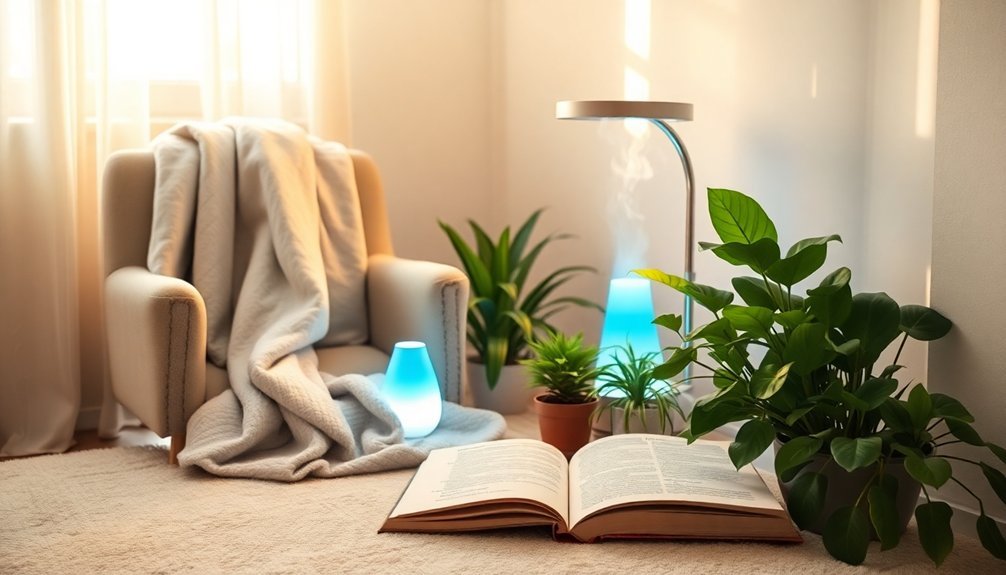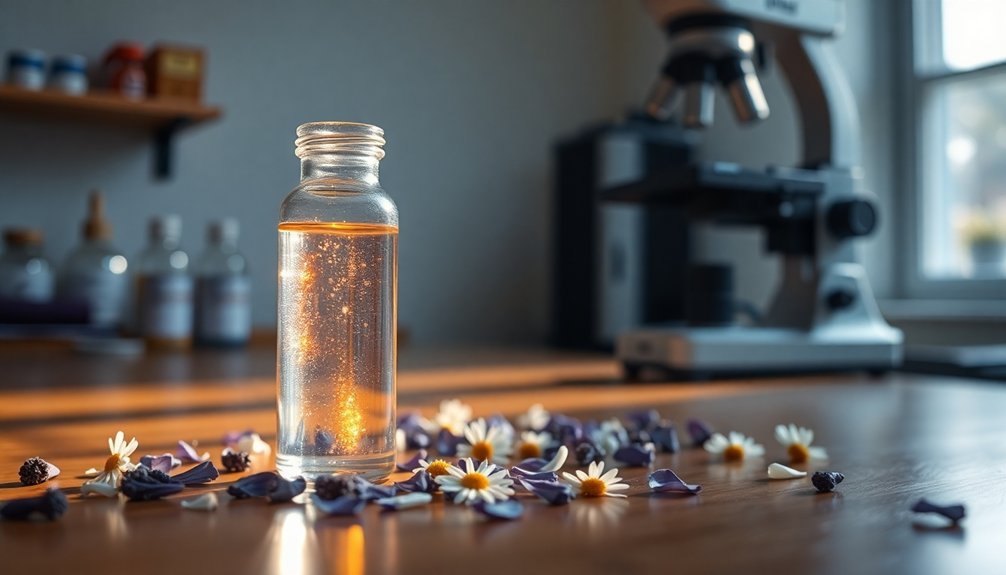Combat seasonal depression with five proven therapeutic approaches that work together. Start your day with a light therapy box, spending 30 minutes near 10,000 lux of full-spectrum light. Get outside for natural sunlight exposure combined with physical activities like winter sports or nature walks. Practice cognitive behavioral techniques to boost your mood through meaningful activities and positive habits. Establish consistent sleep routines with ideal bedroom temperatures and morning sunlight exposure. Fuel your body with mood-lifting foods rich in omega-3s, vitamin D, and magnesium. These evidence-based strategies will empower you to discover renewed energy during the darkest months.
Light Box Morning Sessions

Looking out into the dark winter months, light therapy boxes offer a scientifically proven way to combat seasonal mood changes. These devices mimic natural sunlight, helping regulate your body's internal clock while balancing essential hormones like serotonin and melatonin.
Early morning walks, even on cloudy days, can provide similar benefits to using a light box.
To get the most benefit, position yourself 12-15 inches from a light box that delivers between 2,500 and 10,000 lux of full-spectrum fluorescent light. You'll want to spend about 30 minutes each morning using the device while you work, read, or check emails.
Consistency is key – daily use during daylight saving time, especially right after waking up, can show positive results within two weeks.
Before starting light therapy, consult your healthcare provider, particularly if you have eye problems or bipolar disorder. While light boxes don't require a prescription, it's important to choose one that meets safety standards, though note they're not FDA-regulated.
When selecting your device, consider light intensity, safety features, and style. You can maximize results by combining light therapy with other treatments like antidepressants or psychotherapy, creating a thorough approach to managing winter blues.
Exercise Under Natural Light
Beyond the benefits of light boxes, stepping outdoors for exercise can powerfully combat seasonal affective disorder (SAD). Morning physical activity combined with natural sunlight exposure can reduce depressive symptoms by up to 50%. You'll find that just 30 minutes of moderate exercise most days of the week can markedly stabilize your mood and energy levels throughout winter. Since women face higher risk of developing SAD, outdoor exercise can be especially beneficial for female patients.
| Activity Type | Benefits |
|---|---|
| Winter Sports | Snowshoeing, skiing, and snowboarding provide intense physical activity while maximizing sunlight exposure |
| Daily Tasks | Shoveling snow or building snowmen combines social interaction with natural light therapy |
| Nature Walks | Morning neighborhood walks or trail hiking offer gentle exercise with vital daylight exposure |
| Outdoor Games | Ice skating and sledding deliver both physical activity and mood-lifting enjoyment |
If you're considering treatment for SAD, remember that exercise works best as part of an all-encompassing approach. While indoor activities like swimming and yoga are beneficial, outdoor morning exercise maximizes therapeutic value by combining physical activity with natural light exposure. For the best results, integrate your exercise routine with other treatments such as light therapy or counseling, always under professional guidance.
Cognitive Behavioral Support Techniques

Focus on behavioral activation by choosing engaging activities that boost your mood. Whether it's joining a winter sports club or starting an indoor hobby, take small, actionable steps that lead to positive changes in your daily routine.
Behavioral activation involves several key steps. First, monitor your daily activities to understand the relationships between your activity and your mood. This is crucial for identifying patterns and understanding how your behavior influences your emotions.
Next, identify your values and goals to determine what really matters to you. This helps in focusing on activities that are meaningful and enjoyable.
Simple activation is another important step, which involves scheduling and carrying out meaningful activities to boost your experiences of pleasure and mastery. Even if you don't feel like it initially, planning and engaging in these activities can kick-start your motivation.
Problem-solving any barriers to activation is also essential. This could involve overcoming avoidance behaviors and replacing "DOWN" activities with more "UP" ones that improve your mood. Since SAD affects four times more women than men, it's particularly important to recognize these patterns early.
Incorporating mood-boosting activities into your daily routine can be very effective. Activities such as meditation, cardiac exercise like running or cycling, and anything that makes you laugh can increase serotonin and endorphins, which are natural mood boosters.
Starting small can help make these changes less overwhelming. Choose one activity to do for 10 minutes and include it in your daily routine, whether in the morning or evening, to make it a habit.
Smart Winter Sleep Routines
During winter months, maintaining healthy sleep habits becomes essential for managing seasonal mood changes. You'll want to optimize your bedroom environment by keeping the temperature between 18°C and 22°C and using breathable cotton or flannelette bedding to regulate temperature and prevent dampness. Moderate physical activity helps prevent morning grogginess and boosts energy levels throughout the day.
Start by establishing a consistent sleep schedule, even on weekends. Use an online bedtime calculator to determine your ideal sleep time based on when you need to wake up. Avoid the temptation to hibernate on weekends, as this can disrupt your natural sleep patterns.
Make morning sunlight exposure a priority. Open your curtains immediately upon waking and try to get outside within the first hour of your day. This exposure helps regulate your circadian rhythm and boosts vitamin D production, which can affect your mood during darker months.
Maintain healthy daily routines by continuing your exercise regimen and watching what you eat before bedtime. Practice relaxation techniques before bed, and avoid caffeine after lunch.
If you're struggling to adjust, consider limiting afternoon naps and reducing alcohol consumption, especially in the evening hours.
Nutrition and Wellness Habits

A well-balanced winter diet can substantially impact your mood during the darker months. Focus on incorporating omega-3 rich fish like salmon and mackerel, along with vitamin D sources such as egg yolks and fortified dairy products.
You'll boost your mood even further by adding colorful fruits and vegetables packed with vitamin C, like oranges, strawberries, and bell peppers.
To combat winter blues effectively through nutrition, prioritize these essential elements:
- Lean proteins from chicken, turkey, or legumes to support dopamine production
- Magnesium-rich foods like pumpkin seeds and almonds for their natural calming effects
- Dark leafy greens and whole grains for brain health
- Berries and cherries that help regulate sleep patterns
Don't forget to moderate your evening carbohydrate intake, as it can affect your circadian rhythms. Instead of reaching for comfort foods high in sugar and cream, opt for nutrient-dense alternatives like winter squash, beets, and sweet potatoes.
You can enhance your cooking with healthy fats from olive oil and aromatic spices, making your winter meals both nutritious and satisfying while supporting your emotional well-being.
Frequently Asked Questions
Can Winter Blues Affect Children Differently Than Adults?
Yes, you'll notice children show unique SAD symptoms compared to adults. They're more likely to have trouble at school, display irritability, and struggle with social interactions rather than the typical adult symptoms of lethargy and withdrawal.
How Long Does It Typically Take to See Improvements With SAD Treatments?
You'll typically notice improvements with light therapy in 1-2 weeks, while antidepressants take 4-6 weeks to show full effects. CBT's results vary by individual, but you'll see changes over several weeks of sessions.
Does Having Winter Blues Increase the Risk of Developing Clinical Depression?
While having winter blues doesn't directly cause clinical depression, you may be vulnerable to both conditions due to shared biological mechanisms. It's important to address your symptoms early to prevent potential mood complications.
Are There Specific Genetic Factors That Make Some People More Susceptible?
Yes, you're more likely to experience winter blues if you have specific genetic variations affecting serotonin metabolism and circadian rhythms. If your family members have mood disorders, you've got a higher risk of developing it.
Can Relocating to a Warmer Climate Permanently Cure Winter Blues?
While relocating to a warmer climate can help reduce your winter blues symptoms, it's not a guaranteed permanent cure. You'll still need to think about other factors like lifestyle changes and maintaining mental health support.
In Summary
You've got powerful tools to fight seasonal depression right at your fingertips. By combining light therapy, outdoor activity, CBT techniques, consistent sleep patterns, and proper nutrition, you'll be well-equipped to tackle winter blues head-on. Don't let shorter days dim your spirits – start implementing these strategies today. With dedication to these evidence-based practices, you're taking control of your seasonal well-being and setting yourself up for a brighter winter ahead.





Leave a Reply